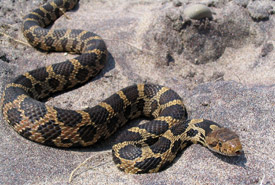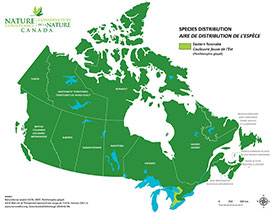
Eastern foxsnake (Photo by Ryan M. Bolton)
Eastern foxsnake
The eastern foxsnake is a provincial and national species at risk whose status was elevated from threatened to endangered in April 2008. This status change came after the recognition of the increased threats due to habitat loss and mortality from road and boat traffic.
This species is also globally rare, existing only around the Great Lakes basin in southern Ontario, Michigan and Ohio. In fact, 70 percent of the entire species population is found in Ontario.
Where is this species found?
Eastern foxsnakes, the second-largest snakes in Ontario, are generally confined to shoreline areas around the Great Lakes — habitat that is quickly disappearing due to development pressures.
What are the threats to this species?
The two recognized sub-populations, Carolinian and Great Lakes/St. Lawrence, face other similar challenges to species survival, including illegal wildlife trade.
The Great Lakes/St. Lawrence population is known for its amazing long-distance swimmers, especially in Georgian Bay. This population is therefore also risk of being killed by boats whose drivers don't see these smooth swimmers in the water.
The Carolinian population, on the other hand, faces higher road mortality threats as a result of the higher road densities in Ontario's far south, where the snakes like to bask and absorb the radiant heat from pavement. Eastern foxsnakes' colouring makes them hard to see on the road and they may go unnoticed or be mistaken for fallen tree limbs by even the most diligent of drivers.
Is it venomous?
The eastern foxsnake is non-venomous but its defensive strategy of vibrating its tail in leaves to simulate the sound of a rattlesnake is so successful that many people mistake it for the venomous eastern massasauga and kill it in fear.
What is NCC doing to protect habitat for this species?
The Nature Conservancy of Canada (NCC) is working hard to make sure Canada does not lose this very special species at risk.
By protecting habitat where eastern foxsnakes live, including the coastlines of the Western Lake Erie Islands and the Eastern Georgian Bay Coast, NCC is addressing one of the greatest threats facing this snake.
NCC also creates vegetation piles (also known as hibernacula) for nesting eastern foxsnakes in order to improve their habitat. NCC will be monitoring eastern foxsnakes and their hibernacula (the shelters they hibernate in) so that we know where to concentrate our habitat improvement efforts for the greatest benefit to the snakes.
Other eastern foxsnake basics
Eastern foxsnakes grow up to one metre long. These snakes actively hunt for prey and are constrictors, squeezing their prey to death. Young eastern foxsnakes will eat frogs and insects, but rodents and bird eggs are the preferred choice for adults.
Females reach maturity around five years of age and only breed every two years. Females lay eggs in rotting logs in late summer and one to two months later the young emerge. When temperatures drop in the fall, eastern foxsnakes find local, communal overwintering sites called hibernacula where they remain until spring.





